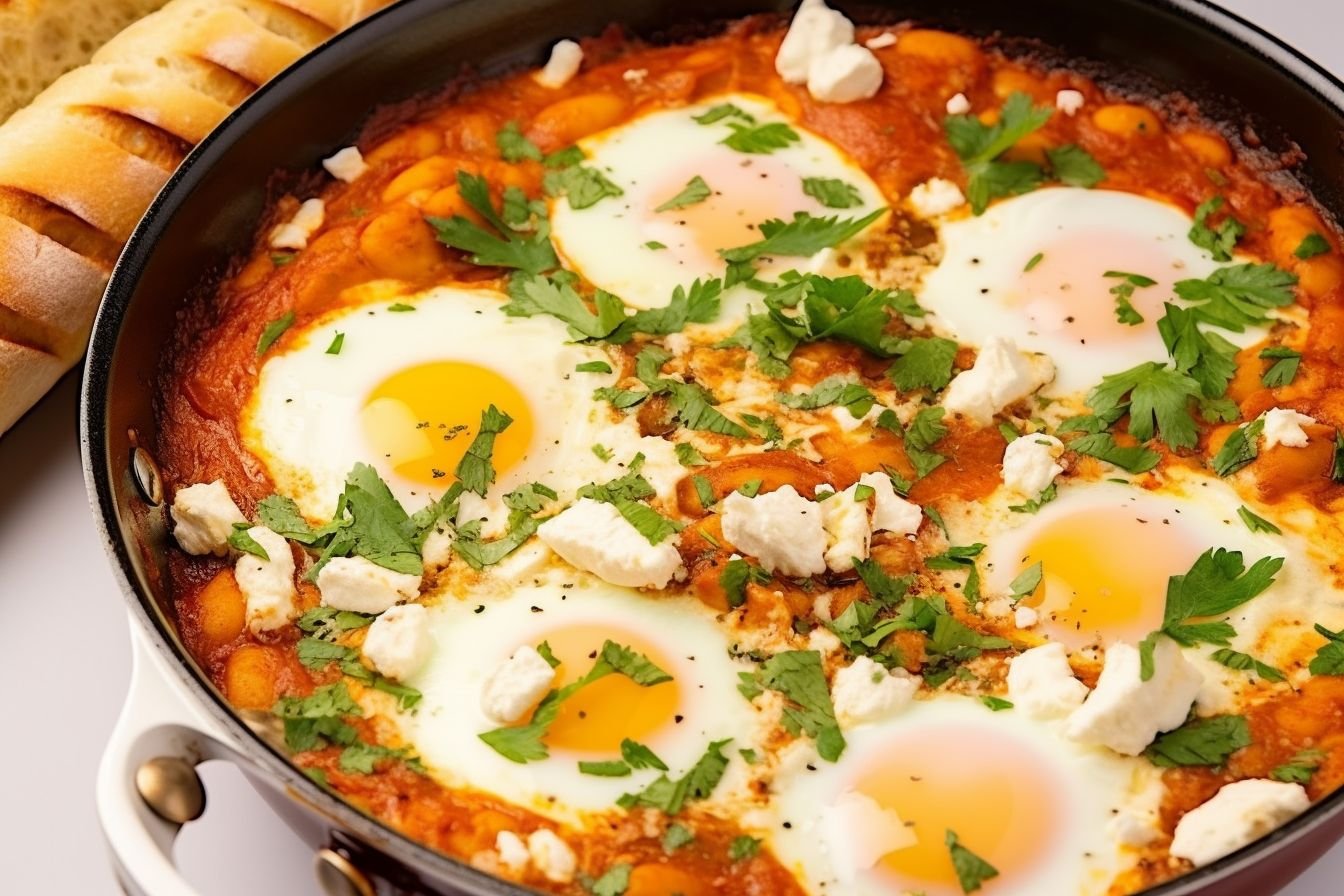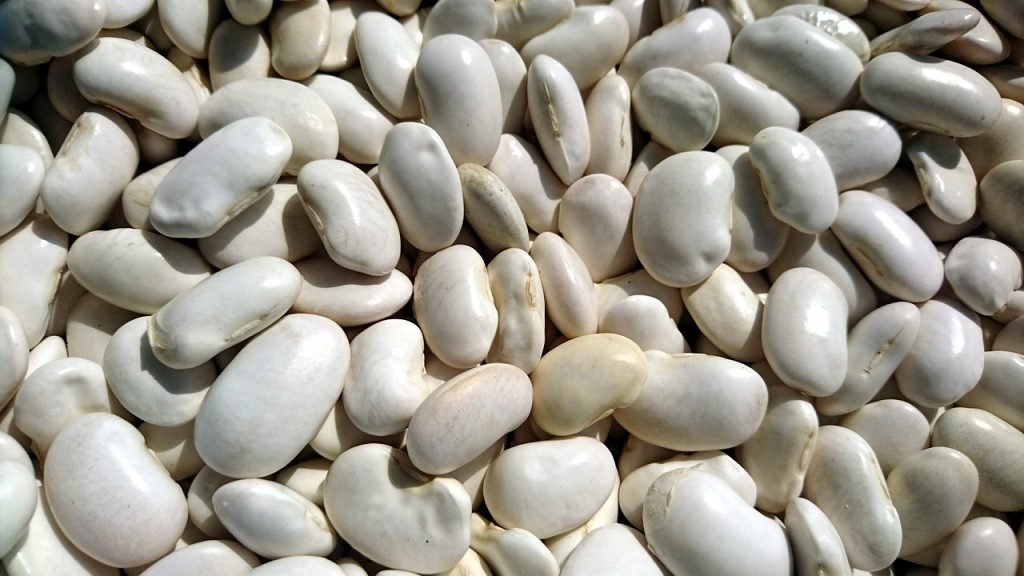Shakshuka with white beans is a popular Middle Eastern dish that consists of eggs poached in a flavorful tomato sauce with the addition of white beans. To make this dish, you will need some basic ingredients such as onion, garlic, olive oil, smoked paprika, coriander, cumin, tomato sauce, salt, and pepper. The addition of white beans adds a creamy texture and extra protein to the dish. I highly recommend using Great Northern beans for the best flavor and texture.
What Is Shakshuka?
Origin and Cultural Significance
Shakshuka is a popular dish in the Middle East and North Africa, particularly in Israel, Egypt, and Tunisia. Its exact origin is unclear, but it is believed to have originated in the Ottoman Empire and spread throughout the region.
The dish is typically served for breakfast or brunch and is made by simmering eggs in a spicy tomato sauce with onions, peppers, and various spices. Shakshuka is often served with bread for dipping and scooping up the delicious sauce.
Why Add White Beans?
Nutritional Benefits
White beans are a great source of protein, fiber, and essential vitamins and minerals. One cup of cooked white beans provides about 15 grams of protein, making it a great option for vegetarians or those looking to reduce their meat intake. Additionally, white beans are high in fiber, which can help regulate digestion and promote feelings of fullness.
White beans bring iron, magnesium, and potassium, crucial for healthy blood pressure, energy, and strong bones. Adding them to shakshuka increases its nutritional value effortlessly.
Texture and Flavor Enhancements
In addition to their nutritional benefits, white beans also add a unique texture and flavor to shakshuka. The creamy texture of the beans pairs well with the rich tomato sauce and runny eggs, creating a satisfying and hearty dish.
The mild flavor of white beans also complements the bold flavors of the spices used in shakshuka, such as cumin, paprika, and chili powder. The beans add a subtle sweetness to the dish, balancing out the acidity of the tomatoes and adding depth to the overall flavor profile.
Ingredients:
- 1 finely diced onion
- 4 minced garlic cloves
- 1 tbsp of olive oil
- 2 tsp of sweet or spicy smoked paprika
- 1 tsp of ground coriander
- 1 tsp of ground cumin
- 24 oz jar of tomato sauce
- Salt and pepper to taste
- 1/2 cup of water (optional)
- 14 oz can of drained white beans (e.g. Great Northern)
- 4-6 eggs
- 1/4 cup of crumbled feta cheese
- 1/4 cup of diced fresh parsley
How to Make Shakshuka with White Beans?
- Heat a big frying pan on medium. Add olive oil and chopped onion. Cook for 5 minutes, stirring, until the onion is soft and see-through.
- Add minced garlic, paprika, ground cumin, and ground coriander to the skillet. Stir-fry the spices and onion mixture for 2 minutes, allowing the flavors to combine.
- Once the spices are fragrant, add jarred tomato sauce to the skillet. If you prefer a thinner sauce, pour half a cup of water into the jar, swirl it around, and then mix it into the sauce.
- Add drained white beans to the skillet and bring the mixture to a gentle boil. Lower the heat and allow it to simmer for 5 minutes. After tasting the sauce, add salt and pepper, if needed.
- To make hollows for the eggs, use a spoon to create 4-6 spaces in the skillet. Carefully crack an egg into each hollow and use a spoon to push some of the tomato sauce around the egg whites to prevent spreading.
- Season each egg with pepper and salt and cover the skillet with a lid. Allow the shakshuka to simmer for 5-10 minutes or until the eggs are cooked the way you like. Keep an eye on it, as cooking times may vary.
- Finally, remove the skillet from heat and sprinkle fresh parsley and crumbled feta over the shakshuka. It’s now ready to serve and enjoy!
Serving Suggestions
Accompaniments
- Bread: A crusty, toasted bread is the perfect vehicle for scooping up the flavorful sauce and creamy beans. Try a loaf of sourdough, ciabatta, or a baguette.
- Rice: For a heartier meal, serve the shakshuka with a side of fluffy rice. Basmati or jasmine rice are both great options.
- Salad: A fresh, crisp salad is a great way to balance out the rich and savory flavors of the dish. A simple green salad with a lemon vinaigrette or a cucumber and tomato salad with a yogurt dressing are both great options.
Garnishes
- Fresh herbs: A sprinkle of fresh herbs like parsley, cilantro, or dill can add a pop of color and fresh flavor to the dish.
- Feta cheese: Crumbled feta cheese adds a salty and tangy flavor to the dish that pairs perfectly with the creamy beans and spicy tomato sauce.
- Olives: For a briny and salty flavor, add a few sliced or chopped olives to the top of the dish before serving.
Recipe Variations
As much as I love the classic shakshuka recipe, sometimes I like to switch things up and try new variations. Here are a few ideas to get you started:
Vegan Options
If you’re looking for a vegan version of this shakshuka, you can easily make some substitutions. Instead of eggs, you can use tofu or chickpeas to add some protein to the dish. You can also swap out the dairy-based feta cheese for a vegan alternative, or omit it altogether. For a creamier texture, you can add some coconut milk or cashew cream to the tomato sauce.
Spice Level Adjustments
If you like your shakshuka on the spicier side, you can add more chili flakes or a diced jalapeño pepper to the tomato sauce. On the other hand, if you prefer a milder flavor, you can reduce the amount of chili flakes or omit them altogether. You can also experiment with different spices, such as cumin, paprika, or coriander, to add some depth to the dish.
Kitchen Equipment Needed
- Large skillet or frying pan: You’ll need a skillet or frying pan that’s large enough to hold all the ingredients for your shakshuka. A 12-inch skillet is a good size for most recipes.
- Cutting board and knife: You’ll need to chop up some vegetables for your shakshuka, so make sure you have a cutting board and a sharp knife on hand.
- Can opener: You’ll need to open a can of white beans for this recipe, so make sure you have a can opener that’s in good working order.
- Measuring cups and spoons: This recipe calls for specific amounts of ingredients, so you’ll need measuring cups and spoons to make sure you get it right.
- Spatula or wooden spoon: You’ll need a spatula or wooden spoon to stir your shakshuka as it cooks.
- Oven mitts or pot holders: Your skillet or frying pan will get hot, so ensure you have oven mitts or pot holders to protect your hands.
Storage and Reheating Tips
- Storage: Let the shakshuka cool to room temperature before transferring it to an airtight container. Store it in the refrigerator for up to 3 days.
- Reheating: To reheat the shakshuka, transfer it to a microwave-safe dish and cover it with a microwave-safe lid or plastic wrap. Microwave it on high for 1-2 minutes, stirring halfway through, until heated through. Alternatively, you can reheat it on the stovetop over medium heat, stirring occasionally, until heated through.
It’s important to note that the texture and flavor of the shakshuka may change slightly after being stored and reheated. The eggs may become slightly overcooked and the sauce may thicken. However, it should still be delicious and satisfying.
Common Mistakes to Avoid
- Overcooking the eggs: One of the most important parts of shakshuka is the eggs. It’s important to not overcook them, as they can become rubbery and lose their delicious runny yolk. Keep an eye on the eggs and remove them from the heat when the whites are set but the yolks are still runny.
- Not draining the beans: If you’re using canned white beans, make sure to drain and rinse them thoroughly before adding them to the dish. Otherwise, the excess liquid can make the shakshuka too watery.
- Not cooking the onions and peppers enough: The onions and peppers should be cooked until they’re soft and translucent before adding the tomatoes and beans. This helps to bring out their natural sweetness and adds depth of flavor to the dish.
- Not using enough spices: Shakshuka is all about the spices, so don’t be afraid to use a generous amount. I like to use a combination of cumin, paprika, and chili powder, but feel free to experiment with different spice blends.
Pairing with Beverages
There are a few options that can complement the flavors of the dish. I have found that the following beverages work well:
- Coffee: A cup of coffee can be a great pairing with shakshuka, especially if you’re having it for breakfast or brunch. The acidity of the coffee can help cut through the richness of the dish, while the flavors of the coffee can complement the spices in the shakshuka.
- Tea: If you’re not a fan of coffee, tea can be a great alternative. A black tea, such as Darjeeling or English Breakfast, can be a good choice as it has enough body to stand up to the flavors of the shakshuka. However, if you prefer something lighter, green tea or herbal tea can work as well.
- Juice: If you’re looking for something refreshing, a glass of juice can be a great option. Orange juice or grapefruit juice can be a good choice as the acidity can help balance out the richness of the dish. Alternatively, a glass of tomato juice can be a great option as it complements the tomatoes in the shakshuka.
- Beer: If you’re having shakshuka for dinner, a beer can be a great pairing. A light beer, such as a pilsner or lager, can work well as it won’t overpower the flavors of the dish. However, if you prefer something with more body, a brown ale or amber ale can be a good choice.
Conclusion
I hope you enjoyed learning about my take on shakshuka with white beans. It’s a delicious and hearty dish that’s perfect for any meal of the day.
By using white beans instead of traditional chickpeas, the dish takes on a creamier texture and a slightly different flavor profile. The addition of feta cheese and fresh herbs like parsley or cilantro adds a burst of freshness and tanginess that complements the rich tomato sauce.
One of the best things about it is its versatility. You can easily customize the dish by adding different vegetables, spices, or proteins like ground lamb or beef.
Overall, shakshuka with white beans is a great recipe to have in your arsenal. It’s easy to make, packed with flavor, and a crowd-pleaser. Give it a try and let me know what you think!
Did you know that pairing shakshuka with lavash bread is very satisfying?
Get its recipe now (by clicking the image below):






